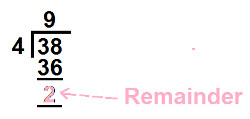Before you study what is a remainder, You are advised to read;
What is a Dividend ?
What is a Divisor ?
Definition:
Remainder is a number which is left in the last at the end of division expression.
Or we can also say that;
Remainder is a number which is left when Dividend is divided by divisor.
Example: In the below long division method, you can notice that 2 is the remainder when dividend 38 is divided by divisor 4

|






